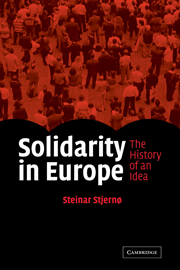Book contents
- Frontmatter
- Contents
- List of tables
- Acknowledgements
- List of abbreviations
- Introduction: to study the idea of solidarity
- Part I Three traditions of solidarity
- 1 Solidarity in classic social theory
- 2 Politics: solidarity from Marx to Bernstein
- 3 Religion: solidarity in Catholicism and Protestantism
- Part II The idea of solidarity in politics in Western Europe
- Part III The present precariousness of solidarity
- References
- Index
1 - Solidarity in classic social theory
Published online by Cambridge University Press: 29 March 2010
- Frontmatter
- Contents
- List of tables
- Acknowledgements
- List of abbreviations
- Introduction: to study the idea of solidarity
- Part I Three traditions of solidarity
- 1 Solidarity in classic social theory
- 2 Politics: solidarity from Marx to Bernstein
- 3 Religion: solidarity in Catholicism and Protestantism
- Part II The idea of solidarity in politics in Western Europe
- Part III The present precariousness of solidarity
- References
- Index
Summary
The phenomenon of group loyalty and sharing resources existed long before the idea of solidarity developed. The core social units of precapitalist society were the family and the extended family. Ties of kinship were the basis for reciprocal loyalty, constituting specific duties and moral obligations. Moral norms required family members to help each other, remain together and defend each other against external threats and hazards. Outside the bounds of family in feudal society, peasants would help one another in the fields or when building houses. In some countries during the nineteenth century peasant solidarity developed a sophisticated cooperative movement that protected against the hazards of life and the growth of a market economy. Craftsmen established guilds that controlled the recruitment of apprentices, organised education and established security funds for their members (Christiansen 1997). Neighbours sometimes helped one another with food and money, when untimely death disrupted the household economy. Help with funeral expenses and looking after the neighbours’ children, were not uncommon practices. The historian Knut Kjeldstadli has called the pre-working-class solidarity of the nineteenth century ‘the community of ordinary people’ (Kjeldstadli 1997). This involved an exchange of favours and services and reciprocal help between people. This behaviour was an everyday practice, the fulfilment of the widespread belief that ‘if I help you then you will help me, if and when the need arises’.
- Type
- Chapter
- Information
- Solidarity in EuropeThe History of an Idea, pp. 25 - 41Publisher: Cambridge University PressPrint publication year: 2005



